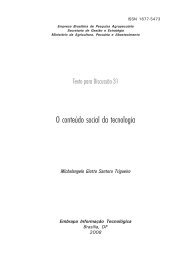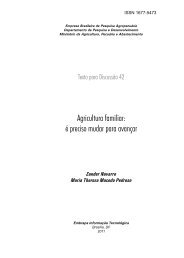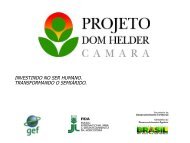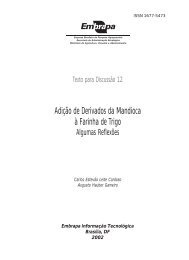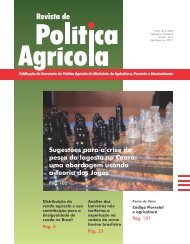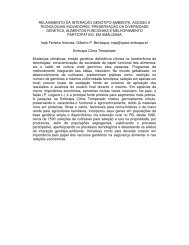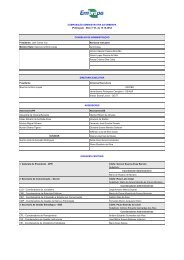Ministry of Agriculture, Livestock and Food Supply - Embrapa
Ministry of Agriculture, Livestock and Food Supply - Embrapa
Ministry of Agriculture, Livestock and Food Supply - Embrapa
Create successful ePaper yourself
Turn your PDF publications into a flip-book with our unique Google optimized e-Paper software.
the charcoal for the steel industry in 1997 <strong>and</strong> 28% <strong>of</strong> all charcoal in 2002.<br />
Technology began to evolve from the traditional kilns to rectangular furnaces,<br />
<strong>and</strong> more efficient processes are gradually being adopted. The use <strong>of</strong> planted<br />
forests also reduces transportation costs.<br />
The interest <strong>of</strong> steel mills in charcoal was renewed due to the prospects<br />
<strong>of</strong> using the CDM to reward "green steel". Cleaner <strong>and</strong> more efficient<br />
technologies are being sought, including the use <strong>of</strong> byproducts (from tar to<br />
effluent gases). It is estimated that the current pig iron production (27-million<br />
tons) would require 17.5-million tons <strong>of</strong> charcoal, with a planted area <strong>of</strong><br />
approximately 3.3-million hectares.<br />
Agricultural <strong>and</strong> forestry residues<br />
The development <strong>of</strong> technologies to treat <strong>and</strong> use residues with a view<br />
to reducing production costs <strong>and</strong> environmental pollution is the greatest<br />
challenges <strong>of</strong> our time.<br />
This challenge is very important in regions that concentrate animal<br />
production activities, particularly swine <strong>and</strong> poultry farms. On the one h<strong>and</strong>,<br />
producers are under pressure to increase productivity <strong>and</strong> the number <strong>of</strong><br />
animals in small production areas. On the other, there are increasing pressures<br />
to ensure that said increase does not destroy the environment. Limited space<br />
<strong>and</strong> the need to meet increasing dem<strong>and</strong>s for energy, good quality water <strong>and</strong><br />
food have presented some challenges to producers, most <strong>of</strong> which are related<br />
to the environmental issue <strong>and</strong> the availability <strong>of</strong> energy (OLIVEIRA, 2003;<br />
SANTOS, 2001).<br />
The energy potential <strong>of</strong> residues is hard to estimate because <strong>of</strong> statistical<br />
unreliability <strong>and</strong> regional variations. Nevertheless, Woods <strong>and</strong> Hall (1994) point<br />
to values close to 93 EJ/year. That number is similar to Smil's (1999), who<br />
concluded that there are from 3.5 to 4-billion tons <strong>of</strong> agricultural residues,<br />
with an energy potential <strong>of</strong> 65 EJ, or 1.5 Gtep. Considering only the main<br />
crops (wheat, rice, corn, barley, <strong>and</strong> sugarcane), Hall et al. (1993) estimated<br />
that it is possible to recover 25% <strong>of</strong> the residues in the form <strong>of</strong> energy, generating<br />
38 EJ <strong>and</strong> thus avoiding the emission <strong>of</strong> 350-460 Mt <strong>of</strong> CO per year.<br />
2<br />
The use <strong>of</strong> residues for energy purposes will compete in the future with<br />
the preparation <strong>of</strong> animal bedding for livestock farms, organic fertilizers, erosion<br />
control, animal nutrition, etc. It would also be necessary to reinforce the concept<br />
<strong>of</strong> residue from the viewpoint <strong>of</strong> the sustainability <strong>of</strong> its exploitation, i.e., not<br />
94



